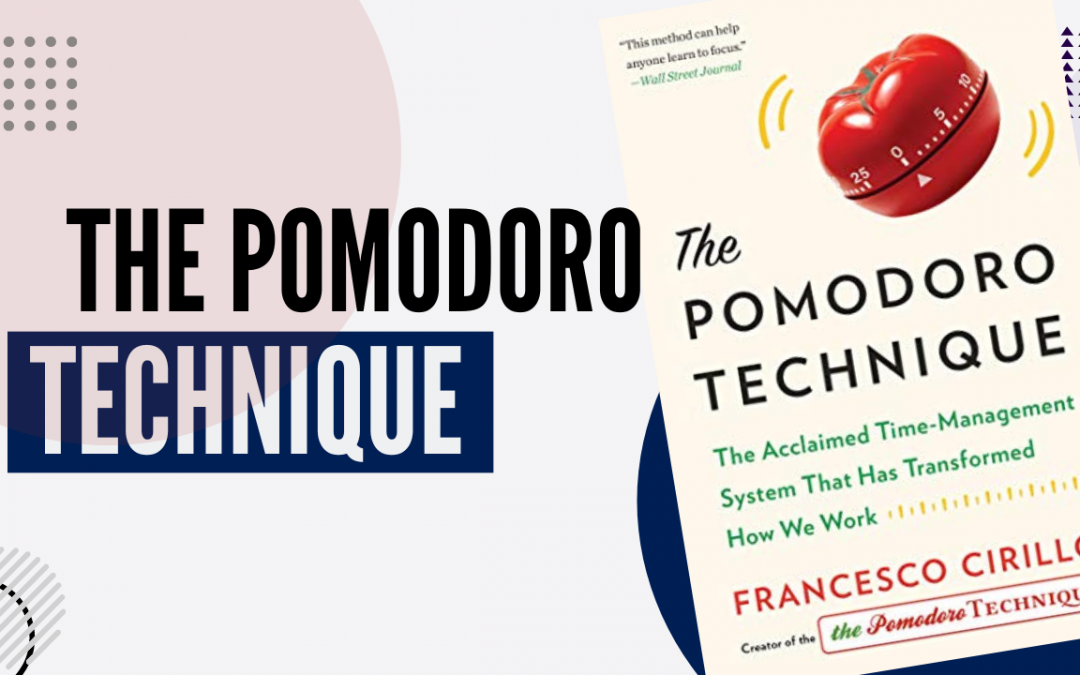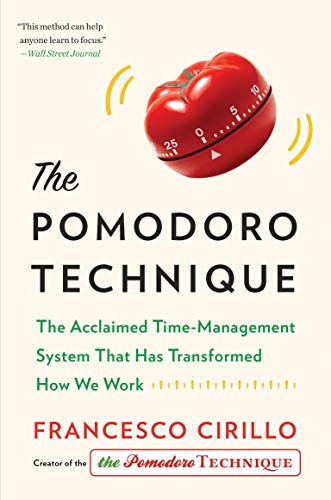What is The Pomodoro Technique? Any ideas?
Well, here is the gist:
The Pomodoro Technique is the easiest approach to manage your time successfully with only two lists and a timer, by breaking down your task into tiny, manageable pieces to remain fresh and focused throughout the day.
What Is the Pomodoro Technique? – A Review
What Is The Pomodoro Technique?
For decades, the Pomodoro Technique has established a following among the world’s best business brains. At its heart is a simple idea: brief bursts of work, broken by regular breaks, promote mental agility and consequently productivity. But how effective is this time-management technique?
Francesco Cirillo is a German-Italian programmer and business entrepreneur. He read a study in college in the 1980s that advised chunking work into reasonable 25 to 40-minute time chunks to make work simpler.
Based on this research, he devised his own time management system, which included a tomato-shaped timer, a pencil, and two paper lists.
But it wasn’t until much later that what is now the world’s most commonly applied productivity strategy hit the globe by storm. Cirillo began actively discussing his approach in the 1990s and released a book with the same title in 2006, in which he outlines it in full.
Over 2 million individuals apply The Pomodoro Technique in their daily lives, so it’s probably worth a go.
Five Big Ideas from The Pomodoro Technique
- The Pomodoro Technique aims to boost productivity. You make use of time as a resource to perform tasks that are essential to you. Time is managed in a good manner that helps you feel in command. When you’re performing a Pomodoro, the passage of time represents your development and achievement of something important.
- You make a To-Do List every day. Cirillo refers to it as your To-Do Today Sheet. Make a place on the page for unanticipated and urgent chores. Create a column in which you record the number of Pomodoros required to perform a job. Prioritize your To-Do list from most critical to least important.
- If a task will take more than five to seven Pomodoros, divide it into smaller tasks.
- Take a 15- to 30-minute pause after completing four Pomodoros. Your brain needs rest and even time to form new connections.
- It takes between seven and twenty days of consistent practice to perfect the Pomodoro Technique.
To get you started, here are the three most important lessons from the book:
- Divide your work into chunks so you don’t drown in it.
- Develop flow and attention by using physical stimulation.
- Commit to each Pomodoro as if it were your wedding day.
Does The Pomodoro Technique Work?
Is the Pomodoro Technique really effective? The simple answer is “maybe.” The more difficult response is “it depends.”
You can concentrate better and finish a job quicker if you split it down and work on it in little increments of time.
What makes it so effective? Because performing the same thing over an extended period of time reduces your performance. This is referred to by scientists as “vigilance decrement,” and it happens when your attention is diverted.
Your brain has a propensity to tune out over time, which is why it ceases noticing frequent stimuli, such as how clothes feel on your skin. You rejuvenate your brain’s attention on that specific activity by splitting your work blocks with brief pauses.
The Pomodoro Technique eliminates distractions, improves attention, and aids with time management. It also makes progress more quantifiable: you can set objectives for how many Pomodoros a task should take and feel accomplished as you cross them off.
Is The Pomodoro Technique Effective?
The Pomodoro Technique works because it makes long-delayed tasks on your to-do list seem less intimidating. If you know you’ll only have to work on a job in short bursts and will be rewarded with frequent breaks, you’ll be relieved of the fear of an unending activity. When implemented correctly, the Pomodoro Technique can put you in a work rhythm where time rushes by without you even realizing it. In fact, five cycles of the whole Pomodoro Technique can get you through an entire workday.
Book Pairing
Two other good books to read together with The Pomodoro Technique book are The 80/20 Principle By Richard Koch and 80/20 Sales and Marketing by Perry Marshall.
How Does the Pomodoro Technique Work?
One of the best aspects of the Pomodoro Technique is that it requires no training to apply. These instructions may differ significantly depending on who you ask. But that’s one of the method’s biggest features: it’s completely customizable.
Cirillo’s Pomodoro technique works as follows:
To get the most out of your Pomodoro sessions, start your day by making a to-do list and detailing the things you need to do. Don’t be concerned if your list becomes too long! Remember that you’ll be splitting up your job to make it more manageable throughout the day. You just need to create a list of what you need to get done today.
Tip: When making a list of your chores, consider how much time you will need to finish each activity. One activity, for example, may take you a complete 25-minute Pomodoro. Alternatively, you may have three small tasks that you may bundle together within one Pomodoro. Make a note of how long each task will take. You may then link tasks that will take less than 25 minutes to accomplish. Your estimates don’t have to be exact, but you want to avoid having time gaps or going overtime during your Pomodoro sessions.
You don’t have to imitate Cirillo and use a tomato-shaped kitchen timer, but a genuine timer will give you the whole Pomodoro Technique experience. It makes no difference whether you use a virtual or real timer; either will suffice. When picking a Pomodoro Technique timer, here are a few alternatives to consider:
Don’t get too caught up in the intricacies of the timer you use. It doesn’t need to be extremely complicated or have any fancy features. To be most effective, keep things simple.
This is the difficult part. After you’ve set your timer, you must work on the activity or projects you’ve selected for 25 minutes without being interrupted. Combating distractions is a difficult task that may need the effort to master.
Tip: If at all feasible, notify individuals around you that you are practicing the Pomodoro approach. This may aid in the reduction of interruptions and external distractions.
Cirillo suggests taking advantage of the chance for overlearning if you find yourself with free time during a Pomodoro and are unsure what to concentrate on. Until the timer goes off, use the time to enhance and clean up your work, reflect on the activities you performed, or make a note of what you’ve learned. Use the 25 minutes wisely and, if possible, avoid beginning your break too early.
You did it! Time is up, and you can take a five-minute break. Consider taking this opportunity to go to the bathroom, have a snack, or refill your water bottle. Allow your eyes to rest and, if possible, restrict your screen time. Get up and move your body around or extend your legs. Taking care of your health can help you stay motivated for the rest of the day.
Are you starting to get the hang of it? Rinse and repeat the preceding steps. Skip step four and go right to step six once you’ve finished four Pomodoros.
You deserve it! This time, take a longer, more restorative break. Take 15-20 minutes to recharge your batteries. Perhaps it is time for breakfast or lunch. Or maybe you’d want to spend some time outdoors in the sun. Whatever the case may be, make the most of your break and be ready to dive back into more Pomodoros afterward.
That’s all. The Pomodoro Technique is a simple approach, so there isn’t much of a learning curve to get started utilizing it to your benefit.
How To Use the Pomodoro Technique
You can incorporate the Pomodoro Technique into your workflow whether you’re a business executive, a university student, or simply someone who needs assistance getting things done. Here’s a simple step-by-step procedure for using the Pomodoro Technique the next time you plan a work session:
- Prioritize the things that must be performed today;
- Estimate the whole work volume and then divide your workflow into little pieces called “Pomodoros” that may be finished in 25-minute increments;
- Include these duties in your plan (whether it’s a project management tool or simply a piece of paper);
- Choose a task, set a timer for 25 minutes, and avoid distractions. Turn off your phone and concentrate on the task at hand.
- When the timer goes off, make a note of it.
- Take a well-deserved break. Take a drink of water and stretch your back. You should return to another Pomodoro after a 5-minute rest.
- Once you’ve completed 4 pomodori, take a 20-30 minute break from your workstation to properly recharge your batteries.
- Go through the session again!
Such a cycle of intense attention and relaxation educates your brain to stick to a schedule, enhancing concentration and combating procrastination, which many people believe is unbeatable. It improves the quality of your output, increases productivity, and assists you in meeting deadlines.
How To Do the Pomodoro Technique
Chris Winfield, a motivational speaker, and entrepreneur battled for years to make good use of his time. Chris has found that the secret to living a constantly productive life is a 25-minute block and a simple timer, after endless hours of study, trial, and error, battling prolonged burnout, and a few head knocks against the wall.
A little background: Chris chose the Pomodoro approach out of desperation to increase his productivity tactics, avoid distractions, and free up more of his time. The Pomodoro technique, developed by Francesco Cirillo in the 1980s, increases productivity by scheduling a 25-minute period of uninterrupted work (also known as timeboxing), followed by frequent breaks.
Chris reduced his workweek in half, revolutionized his profession, and, most significantly, balanced his life thanks to this time management strategy.
Two of the most common queries for folks looking for an efficient time management solution are:
1) Does the Pomodoro technique genuinely work overtime? And
2) How will you maintain the discipline required to use this method? Chris’s advice is straightforward: ‘Yes, it works.’ Simply begin by flossing your teeth.’
No, I mean it. Chris will be the first to admit that he did not begin his productivity adventure with a bang, conquering 40 Pomodoros each week. He didn’t start as a morning person or devote himself to long work hours. It all began with a simple choice to improve his life. For him, it all started with a choice to floss his teeth daily.
“I timed it: it took me 53 seconds to floss my teeth. And I said to myself, “If I can’t spare 53 seconds to do something, then what hope is there that I can accomplish bigger things?’”
Chris knew that it was all about flexing and strengthening his habit muscle. He now has 40 Pomodoro sessions each week, exercises regularly spends plenty of time with his wife and children, and has more free time at the end of the day. Oh, and he flosses regularly.
More about his path to working less and doing more may be found here.
Francesco Cirillo
Francesco Cirillo is a partner of Cirillo Consulting, a Berlin-based business consulting company that works with several of the world’s major corporations. While a university student seeking a strategy to get more done in less time, he developed the Pomodoro technique. His method of working in 25-minute increments with five-minute pauses has been embraced by productivity gurus all around the globe. Cirillo published a 130-page book on the approach in 2006, which he made available for free download. Before the author removed the pdf in 2013, and limited access to the book to his own website, it had been downloaded over 2 million times – around 250,000 times each year. This is the first time the book has been made available for purchase in a retail setting.
The Pomodoro Technique Book
The Pomodoro Technique is designed to boost productivity. You make use of time as a resource to perform tasks that are essential to you. Time is used in a good manner that helps you feel in command. When you’re performing a Pomodoro, the passage of time represents your development and achievement of something important. A timer is required to start the operation. Cirillo suggests using a kitchen timer. You can use a Pomodoro app that you can buy from the Google Play Store. The software emits a clicking sound, letting you know that time is ticking away.
You make your To-Do List every day. Cirillo refers to it as your To-Do Today Sheet. Make a place on the page for unanticipated and urgent chores. Create a column in which you record the number of Pomodoros required to perform a job. Prioritize your To-Do list from most critical to least important. Set a timer for the first job on your list and go to work. Keep in mind that a Pomodoro only lasts 25 minutes. Begin working on your first assignment. Take a three to five-minute pause when the timer goes off. Allow your mind to rest by engaging in an activity that isn’t related to the one you’re working on.
If anything comes to mind while working on your Pomodoro that interrupts what you’re doing, quickly jot down what you need to accomplish and label it to indicate that it’s unplanned and/or urgent. As interruptions occur, use an apostrophe to mark them in the column where you’ll record how many Pomodoros it takes to finish the assignment. This recording of interruptions should just take a few seconds. Continue with the Pomodoro for another 25 minutes.
Your first task on your To-Do list may need more than one Pomodoro. When your break is over, start another Pomodoro to keep working on it.
When you finish the first task on your To-Do list, check it off the list, but keep track of how many Pomodoros it took. This is useful information for you to consider. It allows you to assess your productivity and determine if you need to focus on finishing the task in less time.
If a task will require more than five to seven Pomodoros, divide it into smaller tasks. For example, if you want to learn how to make your company more successful and someone advises that you read Profit First, don’t put it on your To-Do list. It will take you more than three hours to read the book. Instead, split down your reading activities as follows:
- Preview Profit First.
- Read, the Following.
- Foreword
- Preface
- Introduction
- Table of Contents.
- Make a Note of Chapters you Must Read.
- Chapter One.
- Chapter Two.
And, if you read Chapter Two in less than 25 minutes, use the additional time for memory recall – going over what you just read. If, on the other hand, several tasks will take less than 25 minutes to accomplish, consider grouping them together.
Take a 15- to 30-minute pause after completing four Pomodoros. Your brain needs rest and even time to form new connections. This is useful information for me since I have a habit of working on a task for hours on end without taking a break. This habit adds stress to your life and exhausts you.
As you can see, the directions for completing a Pomodoro in Francesco Cirillo’s The Pomodoro Technique are more detailed than in articles and other books. Cirillo also includes instructions in the book on how to employ the Technique as part of a team.
You should not use a Pomodoro timer for tasks that you conduct in your spare time. According to Cirillo, if you’re reading for pleasure, you shouldn’t perform a Pomodoro. It takes between seven and twenty days of consistent practice to perfect the Pomodoro Technique.
Final Thoughts on The Pomodoro Technique by Francesco Cirillo
The main concept of Francesco Cirillo’s The Pomodoro Technique is to concentrate on one thing for 25 minutes at a time, using a timer to keep track. Take a three to five-minute rest after completing a Pomodoro. In what scenarios might the Pomodoro Technique be used?
What to Do After Reading This Review
- If you feel that the extra material in Francesco Cirillo’s The Pomodoro Technique can help you save time, purchase and read the book.
- Determine how the Technique will benefit you at work or in your study if you are a student.
- Share this book review.




